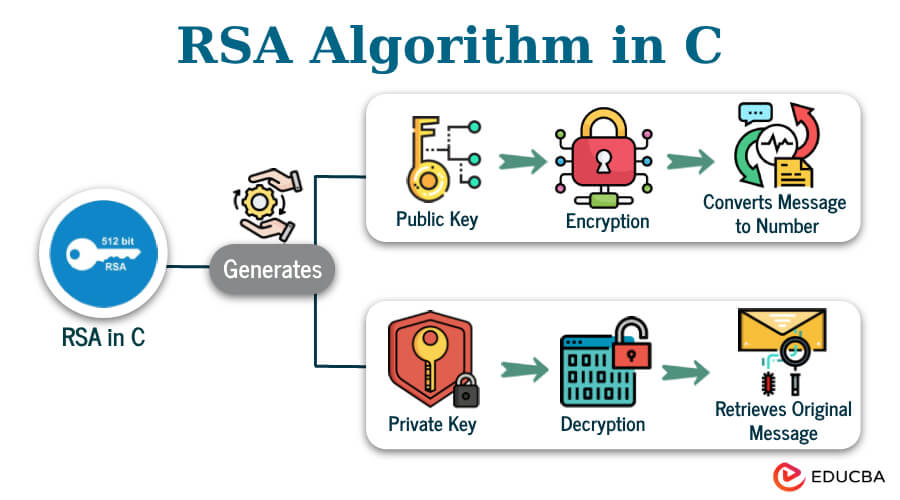RSA encryption, a cornerstone of modern cryptography, serves as a mechanism ensuring secure communications over the internet. Its robustness hinges on the mathematical intricacies underlying prime numbers and modular arithmetic. This article will guide you through the process of implementing RSA encryption in C++, providing an in-depth look at the code while elucidating the various components necessary for a comprehensive understanding.
The RSA algorithm encompasses several key steps: key generation, encryption, and decryption. Each of these phases employs mathematical operations that are foundational to the algorithm’s security. Let us dive into these steps systematically.
1. Key Generation
The first step in RSA encryption is the generation of public and private keys. These keys are mathematically linked, and their security is contingent upon the difficulty of factoring large prime numbers. The following steps are crucial in creating the keys:
- Select two distinct prime numbers, p and q. The security of your RSA key pair hinges on choosing sufficiently large primes.
- Compute the modulus n as n = p * q.
- Calculate the totient function φ(n) = (p-1) * (q-1).
- Select an integer e such that 1 < e < φ(n) and e is coprime to φ(n). Common choices for e include 3, 17, and 65537.
- Determine the private exponent d using the modular multiplicative inverse of e modulo φ(n), ensuring that (d * e) mod φ(n) = 1.
Here is a C++ code snippet demonstrating the key generation process:
#include <iostream>
#include <cmath>
#include <cstdlib>
#include <ctime>
using namespace std;
long long gcd(long long a, long long b) {
return b == 0 ? a : gcd(b, a % b);
}
long long modInverse(long long e, long long φ) {
e = e % φ;
for (long long d = 1; d < φ; d++) {
if ((e * d) % φ == 1) {
return d;
}
}
return -1;
}
pair generateKeys() {
long long p = 61; // Example prime
long long q = 53; // Example prime
long long n = p * q;
long long φ = (p - 1) * (q - 1);
long long e = 17; // Public exponent
long long d = modInverse(e, φ); // Private exponent
return make_pair(n, e); // return (n, e) public key
}
2. Encryption
Once the keys are generated, the next logical step is to encrypt the plaintext message. The encryption process is straightforward:
- Represent the plaintext as an integer m in the range [0, n-1].
- Compute the ciphertext c using the formula: c = (m^e) mod n.
The code for encryption in C++ is presented below. It assumes that the public key has already been generated:
long long encrypt(long long m, long long e, long long n) {
long long c = 1;
for (long long i = 0; i < e; i++) {
c = (c * m) % n;
}
return c;
}
3. Decryption
Decryption is the final phase of the RSA algorithm, permitting the retrieval of the original plaintext from the ciphertext. The steps are as follows:
- Compute the original message m using the decryption formula: m = (c^d) mod n.
Below is the implementation of the decryption algorithm:
long long decrypt(long long c, long long d, long long n) {
long long m = 1;
for (long long i = 0; i < d; i++) {
m = (m * c) % n;
}
return m;
}
4. Complete RSA Implementation
To solidify your understanding, we can integrate the key generation, encryption, and decryption processes into a comprehensive program. This program will utilize standard C++ libraries for input and output.
int main() {
pair keys = generateKeys(); // Generate keys
long long n = keys.first;
long long e = keys.second;
long long plaintext = 65; // Example plaintext
long long ciphertext = encrypt(plaintext, e, n);
cout << "Ciphertext: " << ciphertext << endl;
long long d = modInverse(e, (61 - 1) * (53 - 1)); // Example decryption key
long long decrypted = decrypt(ciphertext, d, n);
cout << "Decrypted: " << decrypted << endl;
return 0;
}
Conclusion
The RSA algorithm exemplifies the interplay between advanced number theory and practical applications in securing digital communications. By meticulously calculating the keys, encoding plaintext, and retrieving original messages, this walkthrough elucidates the foundational elements of RSA encryption in C++. Readers can appreciate the mathematical elegance entwined with algorithmic implementation. The nuances of key generation, encryption, and decryption demonstrate the heterogeneity of cryptographic principles while instilling confidence in digital security mechanisms.








Leave a Comment